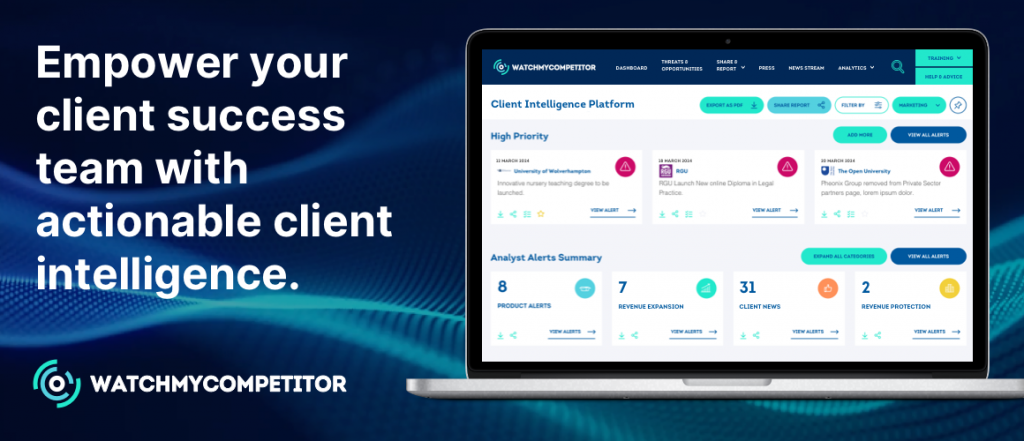Understanding your clients is no longer a luxury; it’s a necessity. Data-driven decision-making is paramount, and client intelligence is the key to unlocking valuable insights that fuel business growth. This article serves as your guide to developing a winning client intelligence strategy in 2024.

Building Your Client Intelligence Strategy
Crafting a robust client intelligence strategy requires a multi-step approach. Here’s a breakdown of the crucial elements, with additional details to consider:
1) Identify relevant data sources
- Customer Relationship Management (CRM) systems: Capture valuable information on past interactions, purchase history and communication preferences.
- Website analytics: Uncover user behaviour on your website, including page views, clicks, and time spent on specific content. Utilise tools like Google Analytics or Hotjar for in-depth insights.
- Social media interactions: Analyse brand mentions, sentiment analysis, and engagement metrics to understand customer perception and preferences. Platforms like Facebook Insights and Twitter Analytics provide valuable tools.
- Surveys and feedback forms: Directly gather client feedback through surveys, polls and feedback forms. This allows you to capture qualitative data on customer satisfaction, pain points, and suggestions for improvement.
- Customer support interactions: Analyse conversations with customer service representatives. Identify common issues, frustrations and areas where product/service improvement can enhance customer experience.
2) Determine data types
- Quantitative data (structured data): Focuses on measurable aspects like demographics (age, location), purchase history (frequency, amount), website behaviour (clicks, time spent), and customer lifetime value (CLTV).
- Qualitative data (unstructured data): Captures the “why” behind the numbers. Analyse customer feedback, social media sentiment, and call centre interactions to understand customer needs, motivations, and pain points.
3) Data analysis techniques
- Leverage data analysis tools: Business intelligence (BI) platforms and customer data platforms (CDPs) can organise, analyse, and visualise client data for deeper understanding.
- Employ data segmentation: Segmenting clients by demographics, behaviour, or needs allows for targeted marketing campaigns and personalised experiences.
For example, segmenting by purchase history allows you to offer upselling or cross-selling opportunities while segmenting by online behaviour allows you to tailor website content and recommendations.
4) Tool selection
Choose the right technology: Consider your budget, data volume, desired functionalities, and scalability when selecting data analysis and visualisation tools. Don’t get overwhelmed by the vast array of options; start with a core set of tools that address your immediate needs and build your tech stack over time.
Leveraging Client Intelligence For Competitive Advantage
By harnessing the power of client intelligence, businesses can gain a significant edge over competitors. Here are some key applications:
A) Personalised customer experiences
By understanding individual client preferences, businesses can tailor marketing messages, product recommendations, and support interactions, fostering stronger relationships and loyalty. Imagine a customer who frequently purchases organic products.
Utilising client intelligence, the grocery store can send them targeted emails with personalised offers on organic items, recommend new organic recipes, and highlight in-store organic product promotions.
B) Predictive analytics
Client intelligence can be used to predict future customer behaviour, allowing for proactive engagement strategies like churn reduction campaigns or upselling opportunities. For instance, an online learning platform can leverage client data to identify students at risk of dropping out.
By analysing factors like login frequency and course completion rates, they can proactively reach out to at-risk students with personalised support or offer additional resources to keep them engaged.
C) Product Innovation
Insights gleaned from client data can inform product development efforts, ensuring offerings align with evolving customer needs and expectations. A fitness app might analyse client data to identify trends in workout preferences.
This insight could lead to the development of new features like personalised workout plans, on-demand fitness classes, or integration with wearable devices.
Challenges & Solutions In Client Intelligence
Implementing a successful client intelligence strategy comes with its own set of hurdles. Here’s how to overcome some of the most common challenges, with additional solutions:
A) Data Silos
Break down departmental barriers and integrate data from various sources to create a unified view of the client journey. Implement a data governance strategy to ensure consistency and accessibility of data across departments.
B) Data quality
Implement data cleansing processes to ensure accuracy and avoid basing decisions on faulty information. Establish data quality standards and procedures to identify and correct errors in your data. Regularly monitor data quality metrics to ensure the integrity of your insights.
C) Actionable insights
Don’t get bogged down in data; translate insights into concrete actions that drive business results. Form a cross-functional team with representatives from marketing, sales, product development, and customer service to ensure insights are translated into actionable strategies across departments. Develop clear KPIs (key performance indicators) to track the success of your client intelligence initiatives.
Case Studies: Effective Strategies In Practice
1) Netflix optimises recommendations

Streaming giant Netflix famously leverages client intelligence to personalise recommendations for each user. By analysing viewing history, ratings, and search behaviour, Netflix suggests content with a high probability of engagement.
This personalised approach has resulted in a significant increase in user satisfaction and reduced churn. A study by McKinsey & Company found that Netflix’s recommendation engine accounts for roughly 70% of what users watch on the platform, highlighting the power of client intelligence in driving user engagement.
2) Amazon tailors product suggestions

E-commerce leader Amazon utilises a sophisticated client intelligence strategy. They analyse purchase history, browsing behaviour, and even abandoned carts to recommend relevant products to individual shoppers.
This personalised approach has significantly boosted conversion rates and customer lifetime value. According to a report by Amazon, personalised product recommendations contribute to 35% of their total sales, showcasing the significant impact of client intelligence on e-commerce success.
3) Starbucks rewards loyal customers

Coffee giant Starbucks leverages its mobile app to personalise the customer experience. By analysing purchase history and app interactions (mobile order frequency, preferred beverage), they offer targeted rewards and promotions.
This data-driven approach incentivises repeat business, builds customer loyalty, and fosters a sense of connection with the brand.
According to a report by McKinsey & Company, members of personalised loyalty programs are 60% more likely to spend more with a brand.
4) The New York Times tailors news content

Even within the media industry, The New York Times utilises client intelligence to personalise news content. By analysing reading history, saved articles, and browsing behaviour, they curate a personalised news feed for each subscriber.
This data-driven approach ensures users see content relevant to their interests, fostering user engagement and subscription retention.
Concluding Thoughts
Investing in client intelligence is not just an option; it’s a strategic imperative for businesses seeking sustainable growth in 2024 and beyond. By understanding your clients deeply, you can create personalised experiences, develop innovative products, and anticipate their needs, ultimately propelling your business towards long-term success.
Want to learn more about implementing a client intelligence strategy? Our comprehensive client intelligence page offers valuable resources and insights to guide your journey.


